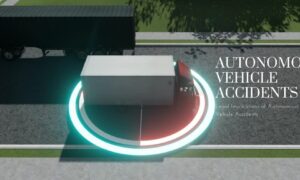Welcome to the future of transportation, where driverless trains are revolutionizing the way we move from point A to point B. Imagine a world without human operators, where sleek and futuristic trains glide effortlessly through cities and across countries. In this blog post, we will delve into the advantages and disadvantages of these autonomous marvels, exploring how they can reshape our lives and communities. Buckle up as we embark on an exciting journey into the realm of driverless trains, a mode of transport that holds immense potential but also raises important questions about safety, employment, and societal impact.
Introduction
There is no doubt that driverless, or autonomous, trains are the future of transportation. The advantages of driverless trains are many and varied, from increased safety to decreased costs. However, there are also some disadvantages to consider, such as the potential for hacking and concerns about job loss.
The primary advantage of driverless trains is safety. By removing the human element from train operation, the risk of accidents is greatly reduced. In addition, driverless trains can react faster than human-operated ones in emergency situations, further increasing safety.
Cost is another significant advantage of driverless trains. Operators no longer need to be paid, which saves money. In addition, maintenance costs are likely to be lower since driverless trains are less likely to be involved in accidents that damage equipment.
Concerns about job loss are perhaps the biggest disadvantage of driverless trains. While it is true that operator jobs will be eliminated, there will still be a need for workers to maintain and repair the equipment. In addition, new jobs will be created in the development and implementation of driverless train technology.
Advantages of Autonomous Trains
There are many advantages to autonomous, or driverless, trains. One advantage is that they can operate 24 hours a day, which can lead to increased efficiency and productivity. Another advantage is that they can be controlled remotely, which can help improve safety. Additionally, autonomous trains can be equipped with technology that allows them to communicate with each other and with traffic control systems, which can further improve safety and efficiency. Driverless trains can reduce the need for expensive infrastructure, such as track maintenance equipment and signals.
Disadvantages of autonomous trains
There are several disadvantages to autonomous trains that should be considered before implementing them on a large scale. Firstly, they are expensive. The cost of development, installation, and maintenance is high. Secondly, they require significant infrastructure changes and might not be compatible with existing railways. Thirdly, they might not be able to deal with unexpected situations as well as human drivers. Fourthly, there is the risk of hacking and cyberattacks, which could disable or hijack the trains. There is public concern about safety and privacy that needs to be addressed.
Comparison between Traditional and Autonomous Trains
There are many potential advantages to driverless trains, including improved safety, efficiency, and reliability. However, there are also potential disadvantages to consider, such as the loss of jobs for train drivers and the high cost of implementing driverless technology.
Traditional trains are operated by human drivers who control the speed and direction of the train. Autonomous trains are operated by computers that are programmed to follow a set route. Both types of trains have their own advantages and disadvantages.
Advantages of traditional trains include the fact that human drivers can react quickly to unexpected situations, such as obstacles on the tracks or sudden changes in weather conditions. They can also use their experience and intuition to make split-second decisions that could improve safety or efficiency. Traditional train drivers also have a better understanding of local conditions than an autonomous computer system would.
Disadvantages of traditional trains include the fact that human drivers can get tired or distracted, which could lead to accidents. They may also make mistakes when operating the controls. Human error is one of the leading causes of train accidents worldwide.
Advantages of autonomous trains include the fact that they can operate 24 hours a day without rest breaks and don’t get tired or distracted. They can also follow routes more precisely than human drivers, which could lead to improved efficiency and punctuality. In addition, autonomous trains can be equipped with sensors and cameras that give them a 360-degree view of their surroundings, allowing them to spot
Safety Concerns with Autonomous Trains
There are many safety concerns that come with the implementation of driverless trains. One of the biggest concerns is the potential for hackers to gain control of the train. If a hacker was able to gain control of a driverless train, they could cause it to derail or crash, causing serious injury or death. Another safety concern is the possibility of malfunctioning sensors or software causing the train to make an unsafe maneuver. For example, if the sensors that tell the train when to brake malfunction, this could lead to a serious accident.
There are also general safety concerns that come with any new technology. For example, there is always the potential for human error when using new technologies. People may not be familiar with how to use driverless trains, and this could lead to accidents. There is also the potential for unforeseen circumstances, such as bad weather, that could lead to accidents.
There are many safety concerns that need to be considered before implementing driverless trains. However, these concerns need to be balanced against the potential advantages of driverless trains.
Recent Examples of Driverless Train Technology in Use
The driverless train is not a new concept. In fact, the first driverless trains were introduced in the early 20th century. However, it was not until recently that driverless train technology was extensively developed and put into use. Below are some recent examples of driverless train technology in use:
The Paris Metro: The Paris Metro is one of the world’s oldest and most extensive subway systems. In 2014, the Paris Metro became the first subway system in the world to fully operate with driverless trains. The switch to driverless trains was made in order to increase efficiency and reduce operating costs.
The Dubai Metro: The Dubai Metro is one of the world’s newest and most technologically advanced subway systems. It opened in 2009 and has been operated by driverless trains since its inception. The Dubai Metro was designed with driverless operation from the start in order to provide a high-quality, efficient, and safe service.
The Vancouver Skytrain: The Vancouver Skytrain is a light-rail transit system that has been in operation since 1986. It was one of the first transit systems in North America to operate with driverless trains. The Vancouver Skytrain switched to driverless operation in 2009 in order to improve efficiency and reduce operating costs.
Conclusion
Driverless trains are just one example of the future of transportation, and it is clear that they offer many advantages. They can reduce traffic congestion, improve safety, and make transportation more efficient. However, there are also some disadvantages to consider, such as cost and the potential for human error in programming them. Ultimately, it is up to each individual or government to decide whether driverless trains are a viable option for their particular situation.



































